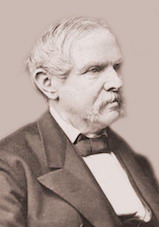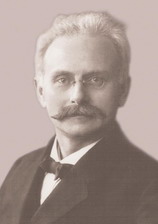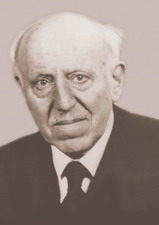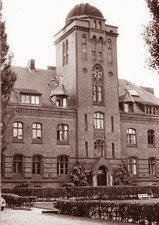
Physics is taught since the founding of the University in 1456 in Greifswald.
1853 an independant chair for the subject of Physics was established.
1857 Fabian Karl Freiherr von Ottokar FEILITZSCH founded a Institute of Physics, one of the first in Germany. In the period from 1877 - 1910 among others Wilhelm HOLTZ worked at the Institute. He is considered one of the inventors of the influence machine.
1891 the Institute obtained a new building under guidance of director Anton OBERBECK.
As the first internationally recognized physicist Gustav MIE was appointed by 1905-1917 for Institute Director. Mie dealt in Greifswald years with the scattering of an electromagnetic wave in a homogeneous dielectric sphere, which he published in 1908 under the title "Contributions to the Optics of Turbid Media, Particularly of Colloidal Metal Solutions". His name is associated with the so-called Mie scattering today. As early as 1903 he led to the description of the attractive and repulsive forces of chemically unattached atoms by the Mie potential.

His successor in office was John STARK, who was one of the leading gas electronic engineers of his time. With this special field, he determined the profile of Greifswald physics, which reaches up to the present day. 1902 STARK had first shown the gas electronics in a comprehensive monograph. 1913 he succeeded with the evidence of splitting of spectral lines in the electric field of a gas discharge. For "his discovery of the Doppler effect in canal rays and of the splitting of spectral lines in electric fields" (STARK effect), he received the Nobel Prize in Physics in 1919. He is thus the founder of gas discharge physics. Very critical of his personality is his involvement in the National Socialism through the "Deutsche Physik" movement.
In 1923 the former institute director Friedrich KRÜGER succeeded to raise funds for an observatory ontop of the institute building. The observatory could be handed over already on 12th July 1924. Along with the cupola a today well-preserved 20cm Zeiss refractor was mounted with a focal length of 3 meters. Following the establishment of astronomical research the further expansion of the attic was carried out in 1929/30. The observatory is today used and serviced through the Greifswalder Sternwarten e.V..

However, the era of Greifswald gas discharge and plasma physics began with Rudolf SEELIGER in 1918. Already 1909 he found his field of research with the subject of his award-winning thesis - the physics of the electric current in the gas. A first fundamental discovery in this area succeeded together with Ernst GEHRCKE 1912 at the Imperial Physical Technical Institute. Both were able to demonstrate experimentally that the excitation of spectral lines in current flow through gases requires minimum characteristic energies of the electrons. The GEHRCKE-SEELIGERian electron impact experiments demonstrated for the first time the existence of discrete energy levels in atoms and represented a precursor of the famous FRANCK-Hertzian impact tests, for which the Nobel Prize was also awarded in 1925. At the end of his scientific career Rudolf Seeliger had developed Greifswald with the modern gas discharge physics to an important center of this area.

The research carried out in the later GDR time research of Greifswald gas discharge and plasma physics remained concentrated in a few subregions due to limited recourses. In addition to the Experimental Physics, the Theoretical Physics and Applied Physics established itself at the Institute end of the 60's. After the political changes in 1989/90, the three directions at the Institute were a crucial starting point for a far-reaching, viable research profile in re-united Germany. Decisive it is thanks to Alfred RUTSCHER that the Institut of Physics was awarded the contract for the establishment of the Collaborative Research 198 "kinetics of partially ionized plasmas" in 1991.
Today, the Institute of Physics represents a broad research portfolio. 11 professors and their research groups work in the fields
Plasma-, Atomic- und Solid State Physics, Quantum Theory, Environmental Physics, Soft Matter and Biophysics, Computational Physics, Medical Physics.
